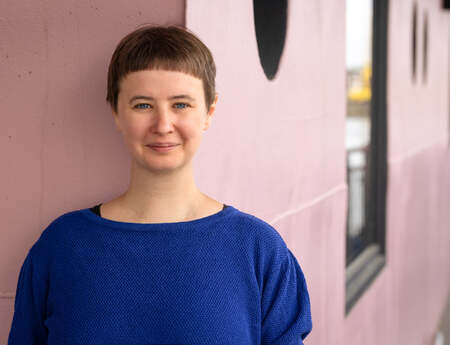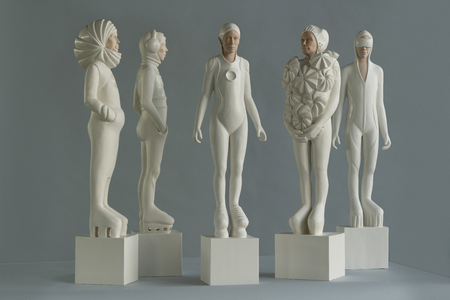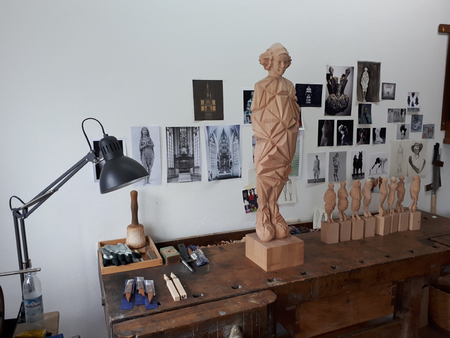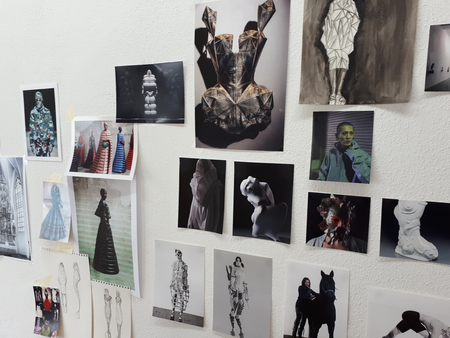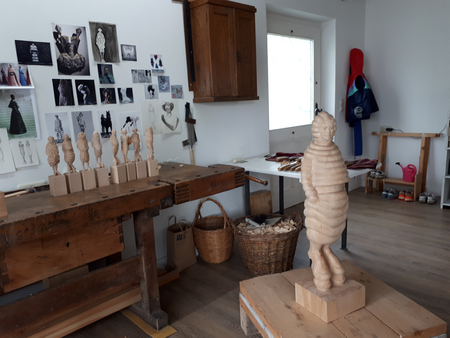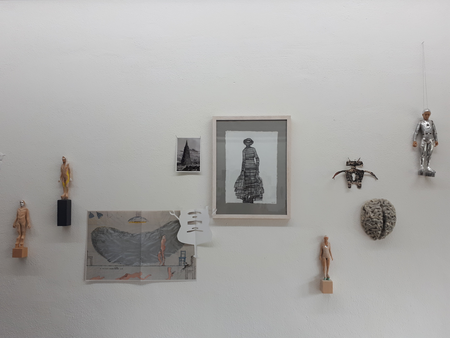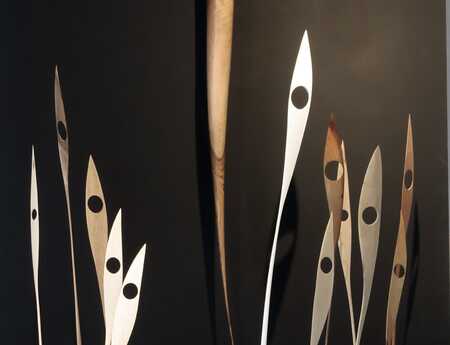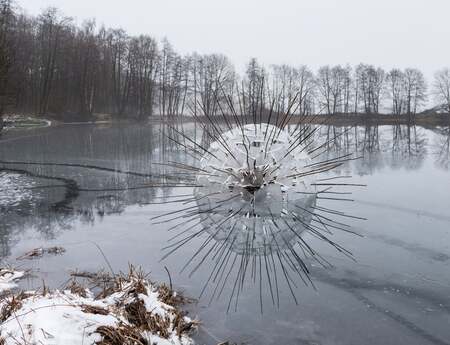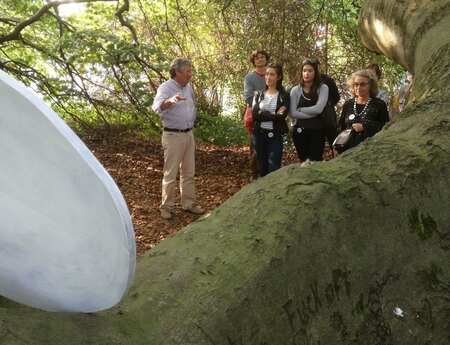Back to the Future
In Katharina Andress‘ sculptures ancient craft meets the human being of the future. The artist condenses questions of Post- and Transhumanism into timeless figures. A conversation about paint-gilding, technoid fashion, prosthetics and rabbit-skin glue.
Katharina, last year you exhibited at the graduation exposition of The Academy of Fine Arts Munich. There you displayed your series Andreonauts and Fashion for Astronauts. I immediately fell for your Andreonauts. Here you worked with a special form of paint-gilding. Could you give us a short explanation?
It’s a traditional technique from Rococo. At that time, sculptors wanted to alienate their figures or feign a more valuable material. I wanted to turn this into something technoid, an almost synthetic surface without being of synthetic material.
How does this process work exactly?
The coat isn’t particularly thick, about three millimetres. That means, every detail one can see is carved. The figure needs to be prepared accordingly – I rasp and sand it, until no traces of carving can be seen. Then I prepare a chalk-based gesso according to old recipes and mix Bolognese and Champagne chalk with a compound of rabbit-skin-glue and water. Rabbit-skin glue is a traditional adhesive made from rabbit skins and bones. By now, there are modern alternatives, however, in the past this was the common glue. In the end, the mix has a creamy texture. It is a bit tricky, because the compound needs to stay warm at all times, but mustn’t get too hot or too cold. Then an approximate fifteen layers are applied with a brush. In between, I sand it then and again to make sure it will be completely even. At the very end, I polish the figure with an agate stone. It tightens the surface, that almost appears as porcelain or marble.
Indeed, at the first glance one cannot believe that the figure is simply made of wood.
Yes, this is why it is so important to me to keep the face recognisably wooden. If the sculpture were white entirely, one could think it’s cast in plastic.
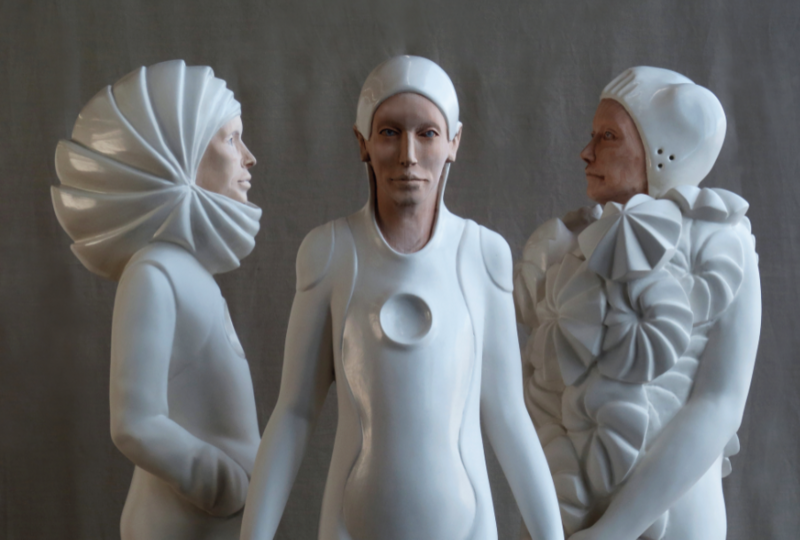
How long does the process from idea to completion of your big figures take?
About two months per figure, for more delicate works it can take longer. The concept phase always starts with a smaller model. To me this is a sort of search for ideas and yet a work of its own. This usually develops into a series of maybe ten figures. Subsequently, I pick about five and enlarge them. It takes several weeks to carve and paint them.
The walls of your studio are covered in sketches and photographs. Next to a cyborg hangs a picture of a late Gothic altar. Again traditional and futuristic elements meet here, just like in your sculptures. What excites you about this combination?
In content, I scrutinise a futuristic theme. At the same time, I employ a very traditional way of production. To me this feels less like a contradiction, but more like an intriguing contrast. Of course, it would be only consistent to say, I’ll use totally innovative new techniques of production and have the figures made by 3D-print. But would it actually still have that tension to it? I don’t know.
The craft aspect of your oeuvre applies a special grounding to it. On the one hand, you take a look at the future, you look far beyond your own nose. On the other hand, you bring this future all the way back to the here and now by working with your hands and with techniques that have been around for centuries.
One sees indeed a condensation of time in these figures and you see how much time went into them. Also through the compression of the material, with every spot I work on so meticulously. This is compressed time. It would lack in a sculpture or figure that comes out of a 3D-printer.
Apropos time. When did you decide to become a sculptress?
After graduating from school. The foundation of this decision was already laid in my childhood. My grandfather was a retired art teacher. At home he had a big workshop where he spent an incredible lot of time with me. I had my own child-size workbench. I just wanted to be there all the time. This is how I started early to experiment with clay, wood and all kinds of materials.
You were trained as a sculptress in Garmisch-Partenkirchen, one of the centres of the wood-carving trade.
I chose to attend a more modern school there. In Southern Germany you encounter a number of schools rich with tradition, however, to me it felt important to not only learn the craft of a Herrgottschnitzer (translator’s note: in Southern Germany and Austria, a Herrrgottschnitzer is the traditional designation for the professional woodcarver mostly occupied with carving Christian or religious imagery). We moulded a lot of nudes and portraits based on our own concepts. There I basically learned the techniques that are my most important means of expression right now.
Afterwards you attended the academy in Munich, what did you learn there?
At the beginning of my studies, I spent much time on art theory. The topic of Post- and Transhumanism was virtually everywhere, and it is still. For the first time, I tried ceramics, for two semesters, but then returned to wood and acquired the craft of paint-gilding.
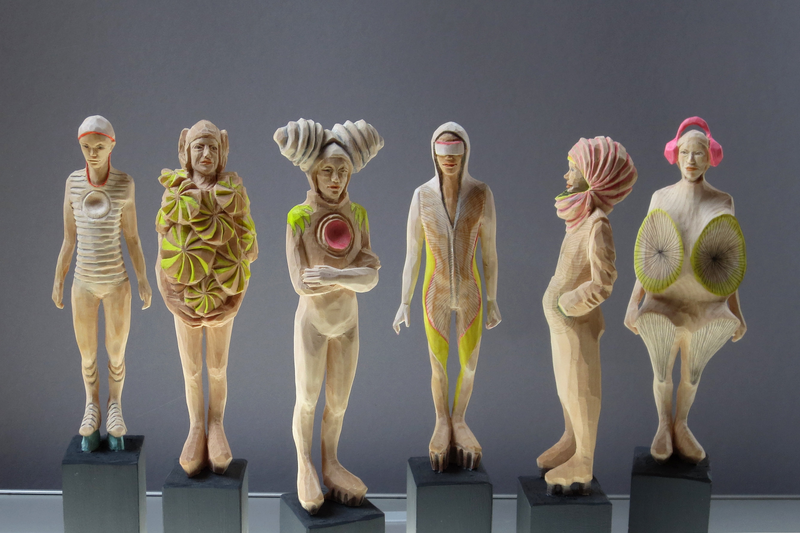
Was there a time when you really failed?
Of course. My digression into ceramics was really ugly. I went down this path full of enthusiasm, wanted to make the figures of porcelain. Then I noticed that I was pushing my limits, that I was lacking time, that I overestimated myself. I thought, if I already master wood, of course I can easily switch to ceramics, but that was utter madness. I fought for weeks and months. I failed magnificently.
How do you deal with these moments of failure?
In failure, to me, there is often a moment of recollection. That is how I returned to wood and paint-gilding then, from which I could start building again. This lead me back to a good level of self-confidence.
Which works can we expect from you in the future?
Since the beginning of the pandemic, my subject has developed a bit further and into a new direction.
I am taking a look at protective gear and masking. Which is omnipresent at this moment. I am asking myself a lot of question about it. How are we, as human beings, developing in the future? Which technical implants and expansions of our bodies will we have in the future? What kind of protective clothing will replace our garments? You can find much about this in fashion, especially with the French company Moncler, whose permanent collections appear humorous and sacred at the same time. Also prostheses and technical expansions of our bodies play a role. In those regards the Korean sculptress Lee Bul and her cyborgs are a source of inspiration.
As part of the sculpture network newsletter, we’ll be taking a virtual tour through Europe this year. Do you have a favourite sculpture place in Germany that you would like to recommend to the readers?
Last year, I made a little dream come true by traveling through the Taubertal valley. There I visited the carved altars by Tilman Riemenschneider. He is a late Gothic wood sculptor. At the beginning of the 16th century, he started working on those altars. Riemenschneider’s workshop was in Würzburg and he worked much in the surrounding area. The Taubertal valley has a beautiful scenery and there are a lot of small and bigger churches, where you can find the altars. They are just fantastic!
Author: Elisabeth Pilhofer
Elisabeth Pilhofer is a Munich-based free-lance editor and culture manager. For this interview, she visited Katharina at her studio in Dießen on a still very chilly May day – and afterwards took a dip in the ice-cold Ammersee lake.

